
Zuojiang River Basin in Southwest Guizhou is the area with the most concentrated Zhuang population in Guangxi and has profound ethnic culture. These elements of Zhuang culture are worthy of our excavation and application, and can be applied to urban construction and landscape planning and design. Therefore, the feature selection method in machine learning was used to purify the items in the personality scale of urban landscape design, and the most meaningful items for describing the urban personality of the case study were found, and the feature extraction method was used to classify the potential structure of the urban personality of the case study. Secondly, using the urban cultural landscape as the representation medium, we use attribute ranking to rank the role of the urban cultural landscape on the personality representation of the urban landscape design, and thus explore the personality representation mechanism of the urban cultural landscape. The design effect shows that this scheme can let different people finally experience the distinctive Zhuang art and humanistic environment.
The Chinese nation consists of 56 ethnic groups, including Han, Mongolian, Tibetan, Zhuang, Hui, and Uyghur, and the Han and 55 ethnic minorities together form the great People’s Republic of China. Among China’s ethnic minorities, the Zhuang have a strong cohesive force, a deep ethnic culture, beautiful natural scenery, and a people who love peace and enjoy life. The city is the nearest land route to ASEAN, and is an important node city between the two corridors of China and Vietnam and Nanning and Singapore [1,2]. It has a rich local ethnic culture, such as Zhuang martial arts, flower cannon snatching, Zhuang bullfighting and five-color glutinous rice. In addition, Chongzuo has many tourist attractions such as mountain scenery, humanistic monuments, rare animals and valuable ancient trees [3]. The highlight of the region is the characteristic ethnic culture, such as Huashan rock painting, Tianqin music art and more than 10 kinds of ethnic culture, so Guangxi is the most ethnic culture characteristic region in the south of China [4].
Landscape design is an important symbol of a city, and the author lives in this land in the border city of southwest Guizhou all the time, so he has to study Zhuang elements in depth, such as Zhuang brocade patterns, Longzhou Tianqin, Zhuang clothing color tones, rock painting figure shapes and colors, which are all national symbols that can be excavated and used [5,6]. In Guangxi Zhuang Autonomous Region, only by highlighting local characteristics and combining the excavation of Zhuang cultural elements with modern urban construction can the characteristic appearance of the city be highlighted [7]. Most landscape designs are very mediocre, either modern buildings or some gardening flowers and lawns, while Zhuang history and culture are rich and colorful, and there are many things to be mined [8]. If we use the above Zhuang elements scientifically and reasonably in the streets, street lights, bus stations, urban sculptures, theme parks, square water fountains and other places in the city, it will be able to highlight the local ethnic cultural characteristics well [9]. Therefore, it is also very important to highlight the ethnic characteristics in the landscape design within the cities of ethnic teacher training colleges and universities [10].
Throughout the country, most of the local undergraduate institutions of urban landscape design are very general, either build a pavilion, or engage in some greenery, or dig a pit to put some water on the line [11,12]. Dry weather in the north, less rainfall, the water in the pool for a long time without treatment is easy to become sewage, the original purpose is to beautify the environment, the result is the water in the pool issued by the odor greatly affects the air environment of the city [13]. There are two main reasons for this, on the one hand, the land area in the urban landscape planning is not large, plus the water part of the whole area accounted for more than half, and the designers do not pay attention to the design of the water around, many places colleges and universities are not featured [14,15]. On the other hand, in urban construction, waterscape design is often neglected, and most of the school’s funds are spent in greening, with little investment in the waterscape part, resulting in a blank overall look and a great waste of space, with waterscape design lacking the embodiment of local symbolic elements, and similar problems exist in the landscape construction of southern Zhuang art (see Figure 1)
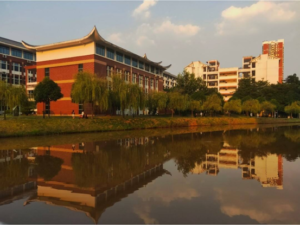
Zhuang culture as an important part of Chinese culture, how can we use flowers, wood, grass and other plants to present the flavor of the national cultural symbolic elements? When carrying out specific landscape waterscape design, in order to reflect the flavor of ethnic cultural elements, it should be manifested from the design concept [16]. Ethnic cultural elements can be fully reflected and expressed in landscape design through different materials and techniques, such as copper drum elements, stone scenery, Huashan rock painting shapes, Zhuang brocade patterns, etc., can be reflected and expressed in urban waterscape landscape through different materials and techniques [17,18].
Our contribution is that the unique character appearance shape and bright color of Huashan rock painting can be used to make some sculptures on the lawn around the waterscape, and the materials can be metal or modern new materials; some strange-shaped stones can be built in the pool, and in the case of large flowing water area, a pavilion can be built with red wood with Zhuangjin patterns, so that the viewers can have a feeling of climbing up and overlooking; the copper drum shape design can be applied to the street lights on the roadside of the waterscape [19]. The design of bronze drums is applied to the street lights and guidance system of the waterscape, and the Zhuang cultural symbols are highlighted in the details of the landscape, so that the waterscape design of the university can show the charm of national cultural characteristics [20].
Firstly, the feature selection method in machine learning was used to purify the items in the personality scale of urban landscape design, and the most meaningful items for describing the urban personality of the case study were found, and the feature extraction method [16]was used to classify the potential structure of the urban personality of the case study. Secondly, using the urban cultural landscape as the representation medium, we use attribute ranking to rank the role of the urban cultural landscape on the personality representation of the urban landscape design, and thus explore the personality representation mechanism of the urban cultural landscape. The data analysis process is based on the well-known machine learning tool library WEKA3.8, which is programmed in JAVA.
Feature selection methods are often used as a data pre-processing step for machine learning techniques. This method is used to remove redundant and useless features by analyzing the intrinsic patterns of the data and finding feature items that are not valuable for characterizing the intrinsic structure of the data. In this paper, the Wrapper-type feature selection method in unsupervised learning is used to analyze each feature item in the Urban Landscape Design Land Personality Scale, in an attempt to select a subset of features that best distinguish the target concept of the scale. The target concept is the potential target to be determined by the scale measurement, and this paper takes tourists’ perception of the overall image of the city as the target concept. The specific steps for feature selection are as follows.
Let the original attribute set be, \(A_P=\left\{a_{P_1}, a_{P_2}, \ldots, a_{P_{32}}\right\}\) by feature selection with a view to obtaining the attribute set:
\[\label{e1} A_P^*=\arg \min _{A^{\prime} p \subset A p} F\left(A_P^{\prime}, Y\right),\tag{1}\] where \(F\left( {A_P^\prime ,Y} \right)\) is the prediction error generated by judging all concepts in the target concept set T by the subset of attributes \({A_P^\prime }\) . Since the analytic expression of \(F\left( {A_P^\prime ,Y} \right)\) is usually difficult to obtain directly and the optimization process is quite complicated, this paper uses the genetic algorithm, a classical optimization algorithm in computational intelligence, to optimize \(F\left( {A_P^\prime ,Y} \right)\) so as to find the feature subset that minimizes \(F\left( {A_P^\prime ,Y} \right)\) .Genetic algorithm is a probabilistic search algorithm for adaptive optimization that simulates the genetic evolution of organisms in nature, and is suitable for optimization of complex nonlinear problems. The genetic algorithm starts from the initial population, uses the natural law of “survival of the fittest” to select individuals, and generates a new generation of population through crossover and mutation operators, and so on, until the goal is met. The algorithm can be described formally as follows:
\[\label{e2} \mathrm{GA}=\{\mathrm{P}(0), \mathrm{N}, 1, \mathrm{~s}, \mathrm{~g}, \mathrm{P}, \mathrm{f}, \mathrm{T}\},\tag{2}\] where \(\mathrm{P}(0)=\{\mathrm{P} 1(0), \mathrm{P} 2(0), \ldots, \mathrm{Pn}(0)\}\) denotes the initial population; N denotes the population size; l denotes the length of the chromosome; s denotes the selection strategy; g denotes the genetic operator, including selection operator \({Q_r}\) , crossover operator \({Q_c}\) and variation operator \({Q_m}\) ; P denotes the operation probability of the genetic operator, including selection probability \({P_r}\), crossover probability \({P_r}\) and variation probability \({P_r}\); f is the fitness function; and T is the termination criterion.
In this paper, the structure of the actual problem is transformed into the chromosome structure of the genetic algorithm using the form of binary encoding, i.e., let each individual be: \({S_j} = {\{ 0,1\} ^{32}}\) , when and only when the dth feature \(1 < d < 32\),\(S_d^j = 1\) ,otherwise \(1 < d < 32\),\(S_d^j = 0\) . The initial population is the set of multiple solutions initially given when solving the problem, which is a subset of the problem solution space. In this paper, we refer to the optimal parameters suggested by Schaffer et al. In this paper, we set the population size N = 100 to generate the initial population by referring to the optimal parameter range suggested by []. The fitness f is the prediction error when predicting \({S_j}\) using the subset \({{A'}_j}\) corresponding to each individual \({y_i}\) , and its function value determines the degree of merit of the individual, which can be defined as
\[\label{e3} f=\frac{1}{N} \sum_{k=1}^N c\left(y_k, \hat{y}_k\right).\tag{3}\] Here \(c\left( {{y_k},{{\hat y}_k}} \right)\) is the prediction cost incurred when the true target concept of sample \({{x_k}}\) is \({{y_k}}\) and the predicted concept is \({{{\hat y}_k}}\) . \(\partial N\) is the data set size, where is taken as:
\[\label{e4} c\left(y_k, \hat{y}_k\right)=\delta\left(y_k \neq \hat{y}_k\right), \quad \delta(b)= \begin{cases}1, & b=\text { TRUE } \\ 0, & b=\text{FALSE}\end{cases}\tag{4}\]
Equation selection is the selection of a number of individuals from the current population according to the population probability and the fitness value of each individual. In this paper, we set the crossover probability \({P_c}\)= 0.6, and the mutation probability \({P_m}\)= 0.005 by reversing the binary number of genes, changing 0 to 1 and 1 to 0. The specific population evolution process In each iteration, 60% of the individuals were selected for crossover by roulette wheel selection according to the crossover probability (\({P_c}\)=0.6), and 0.5% of the individuals were randomly selected for mutation according to the mutation probability (Pm=0.005). Adaptation f was evaluated at the end of each iteration to ensure that individuals with high adaptation would have a higher probability of appearing in the next generation of the population.
Attribute ranking refers to the ordering of attributes based on their discriminative power. Information gain is a common indicator of the discriminative power of an attribute and is often used for attribute ranking. Information gain is calculated by calculating the change of information entropy of an attribute after dividing the sample set to quantitatively characterize the discriminative ability of the attribute. In this paper, we rank urban cultural landscapes in different dimensions based on the information gain, so as to achieve the task of selecting the most discriminative attribute for the personality of the urban landscape design place from the urban cultural landscape.
Given a sample set S containing the values of c target attributes, then the entropy of S with respect to the c classes is defined as
\[\label{e5} \text { Entrop } y(S)=\sum_{i=1}^c-p_i \log _2 p_i.\tag{5}\]
In Eq. (5), \({P_i}\) is the proportion of S belonging to category i. If all samples of S belong to the same category, then the entropy of S is 0; if the number of categorical samples in S is equal, the entropy is 1. If not, the entropy is between 0 and 1. Since entropy is measured by the number of binary bits to encode the length, the logarithmic base is 2. If the target concept has c possible values, then the maximum possible value of entropy is log2c. The information gain of an attribute A relative to the sample set S Gain(S,A) is the expected entropy reduction due to using this attribute to classify samples, i.e.:
\[\label{e6} \operatorname{Gain}(S, A) \equiv \operatorname{Entropy}(s)-\sum_{v \in \operatorname{Values}(A)} \frac{\left|S_v\right|}{|S|} \operatorname{Entropy}\left(S_v\right).\tag{6}\] Values(A) is the set of all possible values of attribute A; \({{S_v}}\) is the subset of S in which the value of attribute A is v, i.e., the first term in \(S_v=\{s \in S \mid A(s)=v\}\) is the entropy of the original set S. The second term is the expected value of the entropy after classifying S with A, i.e., the weighted sum of the entropy of each subset, and the weight is the proportion of samples belonging to \({S_v}\) to the original sample \({\frac{{\left| {{S_v}} \right|}}{{|S|}}}\).
The Zhuang people have a deep connection with water, and in addition to highlighting the Zhuang cultural symbolic elements in landscape water features, the embodiment of their humanistic spirit is also very important. No matter how well the traditional elements of the nation are used, modern design is after all for people. The key to the embodiment of humanism in urban waterscape design is the landscape atmosphere, the most reflective of the space atmosphere is the sculpture, if the sculpture with new materials made of scholars or heroic deeds of content, so that students, passers-by, viewers passing this scene, will raise their eyes up, in the mind to present the image of the story of the association of people, this is the best way to convey the human spirit of the landscape. Sculpture is an important part of the square environment, containing a rich form of language, can resonate with the audience with specific gestures and shapes to convey the designer’s emotions (Figure 2 and Figure 3).

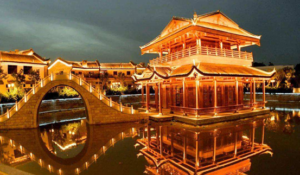
Zhuang art uses artistic expressions in the landscape to refine artistic symbols in the form of sculptures, functional buildings, signs and other forms as a carrier of culture and human experience, realizing the aesthetic needs of the masses and enriching their spiritual and emotional worlds. Only a landscape that meets human needs is a humanized landscape. Therefore, only when Zhuang art symbols are humanized in the urban landscape is the true embodiment of its value. In addition, in the specific expression of the design, the ergonomics, psychology, physiology, anthropometry and other disciplines should be considered in a comprehensive analysis, fully use the laws of formal beauty and the basic principles of landscape creation, through the organic combination of points, lines, surfaces and bodies, the landscape volume, shape and color, texture, proportion, scale, composition and other artistic treatment, to create a humanistic, in-depth understanding of the audience’s emotions. The humanized urban landscape that can interact well with the audience, as shown in Figure 4.
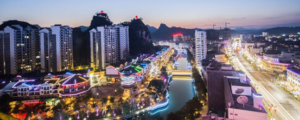
Urban landscape design as a sign and symbol is a long-term existence of urban characteristics of the environment, if the landscape does not meet the requirements of the play and reconstruction, not only waste huge amounts of money, but also affect the coordination of the urban ecosystem and humanistic spirit. Therefore, the urban landscape design must be strictly controlled, and the feasibility analysis of urban square design needs us to adhere to the ecological principle of sustainable development, from the overall coordination of urban natural factors and human factors. By means of contrast, adjustment, integration, embedding and symbolism, we borrow and reproduce nature in different regional space environments, make Zhuang art symbolic elements participate in the cycle of the ecosystem, reflect the connotation of culture, and rediscover its aesthetic and value. It really enables the audience to experience the harmony, beauty and joy brought by the infinite ecological environment in the limited regional space. Only by considering both sustainability and ecological harmony according to local conditions can landscape design continue the cultural lineage of the landscape and make the landscape pass on for a long time, as shown in Figure 5.
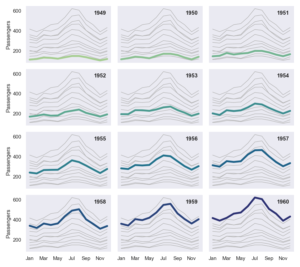
Nanning, Guangxi is a veritable green city with many famous scenic spots. One of the excellent cases is Nanning Qingxiu Mountain Scenic Area. First of all, this mountain consists of 18 large and small ridge such as Qingshan Ridge and Phoenix Ridge, and there are more than two dozen attractions in the tour such as Buyun Gate, Yuntian Pavilion, Tower Shadow Lingyun, Qingxiu Mountain House, Lotus Pond, Haohao Pavilion and Ancient Road. Secondly, the tower shadowing the sky pond with the dragon elephant tower and the sky pond to the north, this scene is the most typical attraction of this park, but also one of the “ten landscapes” in Nanning. In general, the scenic spot of Qingxiu Mountain not only reflects the Zhuang cultural elements, but also shows the historical and cultural deposits since the Ming and Qing dynasties and the achievements of modern people’s conservation and restoration. The second case is “Chongzuo City Garden Expo Park”. This scenery is located in the new area of the south of Chongzuo City, with the city exhibition park, the main pavilion, Zhuang Culture Park, landscape bridge, Guilong Pavilion, precious ancient trees and other projects. Among them, the Zhuang Culture Park, which is the main pavilion in the garden, includes Zhuang Culture Life Hall, Mahogany Museum and Sugar Museum, all of which are two-story outer corridor type sloping roof buildings. The biggest highlight of the “Garden Expo” is the entrance gate with two large bronze drums on the stone columns on both sides, which is also the most characteristic cultural symbol element of the Zhuang people.
The posterior probabilities of the individual models obtained in 3 were used as the prior probabilities of the individual models under sample \({y^B}\) by using sample \({y^B}\) to judge the effect of the previous period’s combined prediction. The posterior probabilities of the updated individual models were obtained by applying Winbugs software to the sample data \({y^B}\) for simulation analysis again. Finally, the posterior probabilities of the updated individual models are used as weights, which in turn leads to the new combined prediction model. Thus, the posterior probabilities of the individual models can be updated continuously whenever new information arrives, which is of great importance for updating the portfolio weights dynamically and in a timely manner.
Based on the above steps, our method prediction results are shown in Figure 6 and Figure 7.
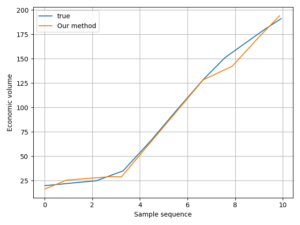
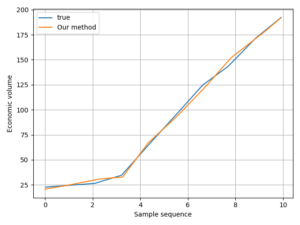
The prediction results of the above three combined prediction methods are shown in Table 1. In this paper, the prediction average relative error \(\hat e\) of the model is used as the evaluation standard, and then the average relative error of the prediction estimate is analyzed. The specific results of the error analysis are shown in Table 2, and the calculation formula of error \(\hat e\) is
\[\label{e7} \hat{e}=\frac{1}{n} \sum_{i=1}^n\left|\frac{\hat{y}_i-y_i}{y_i}\right|.\tag{7}\]
In the above formula, \({y_i}\) is the real value of annual coal consumption and \({{{\hat y}_i}}\) is the predicted value of annual coal demand.
| Particular year | Actual annual coal consumption | Predicted value of linear regression model | Marginal likelihood BMA prediction | Maximum likelihood BMA prediction |
| 1999 | 92.357 | 90.021 | 90.987 | 91.234 |
| 2000 | 93.247 | 96.574 | 95.247 | 94.258 |
| 2001 | 95.247 | 98.574 | 97.874 | 97.584 |
| 2002 | 100.687 | 98.547 | 98.214 | 99.257 |
| 2003 | 119.657 | 121.127 | 121.001 | 120.471 |
| 2004 | 138.174 | 140.547 | 139.874 | 139.124 |
| 2005 | 155.257 | 157.847 | 155.574 | 154.574 |
| 2006 | 170.241 | 163.528 | 164.874 | 165.328 |
| 2007 | 184.574 | 181.324 | 181.567 | 182.352 |
| 2008 | 195.721 | 191.357 | 195.874 | 196.357 |
| Prediction method | Average relative error | Maximum relative error |
|---|---|---|
| linear regression model | 0.0214 | -7.146 |
| Marginal likelihood BMA | -0.0156 | -6.514 |
| Maximum likelihood BMA | 0.0111 | -3.984 |
The first 15 sets of data in the initial sample space were selected as the training sample set for our method model, and the classification accuracy of the model reached 100% at the 100th generation of genetic variation after several iterations, as shown in Figure 8. At this point, the structure of the trained ELM model was optimal. The last 5 sets of data in the initial sample space were selected as the test sample set, and the optimized ELM model was used to simulate and predict them.
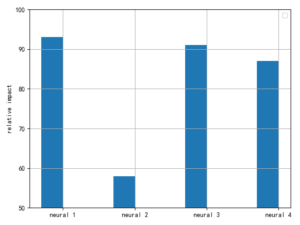
To further highlight the superiority of our method model, the prediction results were compared with the traditional single ELM, SVM and BP models (see Table 3). The results show that: ELM and SVM based and SVM algorithms were both 80% and 80%, while the prediction accuracy of the BP algorithm was only 60%, and the prediction accuracy of the improved our method model was 100%, which was higher than that of the traditional single ELM, SVM and BP models. The prediction results reflect that our method algorithm, optimised based on factor analysis, has a high accuracy in identifying coal and gas prominence with complex non-linear characteristics, and its application to coal and gas prominence prediction can provide a reliable basis for disaster risk prediction and control.
| Serial number | Actual protrusion type | our method prediction results | ELM prediction results | SVM prediction results | BP prediction results |
|---|---|---|---|---|---|
| 16 | 1 | 1 | 1 | 1 | 2 |
| 17 | 3 | 3 | 3 | 3 | 3 |
| 18 | 2 | 2 | 3 | 2 | 2 |
| 19 | 1 | 1 | 1 | 2 | 2 |
| 20 | 4 | 4 | 4 | 4 | 5 |
Zhuang art is the core of the whole urban landscape construction, and the design concept and the method of performance are crucial. Highlight the ethnic regional culture, combine with urban culture to shape the characteristic waterscape, use different design techniques to deal with the drainage and water supply functions, create multi-level waterscape and convey the humanistic spirit. Only by realizing the functions in waterscape design and focusing on the integration of cultural connotation and specific symbolic elements can viewers identify more with the environment they live in and feel the cultural information brought by the landscape to people. In short, environmental design workers whether the overall design of the landscape, or the main water feature location design, the most important thing is how to make the design and the landscape around the building, the crowd, the environment to produce a harmonious relationship. From the aesthetic point of view, so that it meets the psychological needs of people, and ultimately let the landscape art for the urban environment ecological requirements of the service.
This work was supported by Jinma: Suzhou University Talent Project Special Fund Project No.: Ph.D. Research Fund Project 2023BSK081; Wu Qiong: Chizhou University Introduction of Doctoral Fund Project No.: 2020YJRC005.